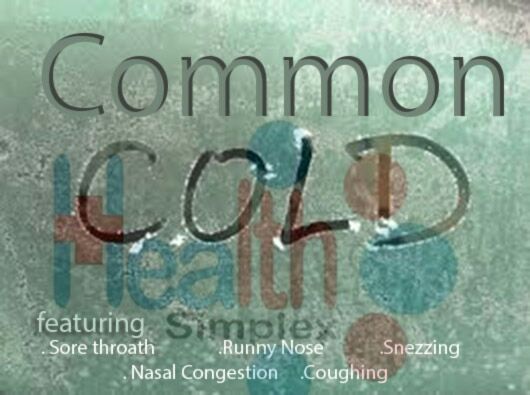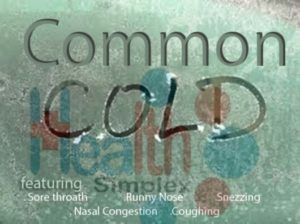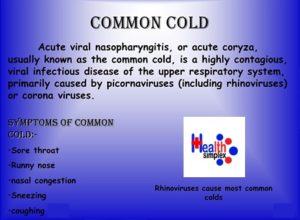
18 Sep It is common and called the Common Cold.
It is that time of the year again, when everyone including you and I, go around with runny nose, itchy throats, nonstop sneezing and sometimes watery eyes which are all absolutely inconveniencing. We all blame it on the rain, the damp weather isn’t good for me, you decide. Cold weather plays a role, in that it leads you to spend more time indoors, where you might be in close contact with people who are contagious, also, the cold weather can make the lining of your nose drier and more susceptible to a viral infection, the low humidity also causes an increase in viral transmission rates.
The weather isn’t totally to blame, there are numerous viruses everywhere that cause these symptoms. So today, we will be discussing
Acute nasopharyngitis commonly known as the Common cold.
Common cold is a viral infection of the upper respiratory tract, primarily affecting the nose, the throat, sinuses and voice box may be affected. It is the commonest acute respiratory infection.
CAUSES
It is usually caused by viruses but very few can be caused by bacterial organisms, with Rhino virus being most implicated.
Non- viral agents have also been reported as a cause of Common cold, and they include:
Generally, non- viral agents are considered as secondary invaders meaning that they are there because something else has created the opportunity for them, example, an immuno-suppressed state.
MODE OF SPREAD
The virus is transmitted through airborne droplets, you can catch it from another person who has the virus, this can happens when you touch surfaces that have the virus on it, examples, door knobs, plates, spoons etc, or if the person near you is sick and sneezes into the air. However, hand to hand or hand to surface contact is the commonest mode of spread. The cold begins as soon as the virus attaches to the lining of your nose or throat, your body’s defense mechanism; the white blood cells are activated leading to an increased production of mucus as a result of your inflamed nose and throat.
EPIDEMIOLOGY (characteristics):
1. Common during the rainy season and harmattan.
2. In children, it is mostly seen in those attending day care.
3. Also in children, frequency of attack is usually 6-8 episodes/year, this is because their immune system is not strong enough to fight the virus.
4. More common during infancy.
SIGNS AND SYMPTOMS (CLINICAL FEATURES)
Clinical features as seen in children:
a. Sneezing
b. Runny nose ( rhinorrhea)
c. Nasal blockage
d. Sore throat
e.Fever: Usually low grade ( <38 .5="" p="">
f. Cough which is usually worse at night due to post nasal drip [ Post nasal drip is mucus draining from your nose into your throat].
g. Headache, fatigue and loss of appetite may be present.
Clinical features as seen in adults:
a. Scratchy or sore throat.
b. Sneezing.
c. Nasal congestion or Stuffy nose.
d. Watery eyes.
e. Post nasal drip.
f. Headache, fatigue and loss of appetite may be present.
g. In adults, other symptoms such as high fever or muscle pains may also point to the flu rather than common cold.
PROGRESSION
A cold usually begins with fatigue, sneezing, a feeling of being chilled and a headache. The runny nose and cough may come almost immediately or follow some days later. Symptoms may peak after two or three days of onset.
DURATION
Symptoms may begin less than two days after exposure to the virus. Most colds last about 7-10 days, but if symptoms persist, see a doctor. This is because the cold might lead to an opportunistic infection by a bacteria, leading to an infection in your lungs, sinuses or ears. In this case, antibiotics can be given because they work on bacteria not viruses.
DIAGNOSIS
It is diagnosed clinically. Investigation is not necessarily needed.
Differential diagnosis in children:
1. Allergic rhinitis: There is usually eye itching, and no fever. Sneezing is usually more frequent. There is a positive family history of allergy.
2. Prodromal stage of infections like measles, pertussis.
3. Acute bacterial pharyngitis: Here, exudates (discharges or secretions) over the tonsils can be seen.
PREVENTION
The primary methods are hand washing, staying away from other sick people and not touching the eyes, nose or mouth with unwashed hands.
TREATMENT
It is a self-limiting condition. Treatment is essentially symptomatic.
In adults, all they need is to rest and stay hydrated. This is because insufficient sleep and malnutrition have been associated with an increased risk of developing an infection following an exposure to the virus.
Treatments that alleviate symptoms such as fever and headache can be taken, this include simple analgesics and antipyretics such as paracetamol and Ibuprofen.
Antihistamines may improve symptoms in the first day or two, nasal decongestants are also effective in adults and may reduce nasal stuffiness.
Zinc supplements may help to reduce the prevalence of cold, vitamin C does not reduce the risk or severity but it may reduce the duration.
In children, the following can be done:
1. Alleviation of fever using paracetamol.
2. Nasal toileting… involves removal of nasal secretion using twists of cotton wool or moistened wick as recommended by WHO. ( nasal obstruction can interfere with feeding).
3. Antibiotic use is not recommended unless there is secondary bacterial infection.
4. The use of vitamin C is controversial.
NOTE
Cough syrup is NOT recommended for children, because many of the available cough syrups depress cough which is actually a protective mechanism. Some may even cause respiratory depression.






No Comments